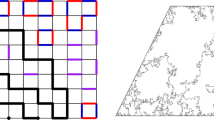Abstract
We study a dimer-trimer lattice model for heterogeneous catalysis for the reaction 1/2A2+1/3B3→AB. The A2 and B3 particles require two and three active sites for their adsorption onto the lattice, respectively. The model is unusual in that it possesses an infinite number of absorbing states whereby the lattice is “poisoned” and reactions must stop. Previously studied models have only two absorbing states. In one dimension, the lattice poisons with mostly dimers and a few trimers even at vanishingly small dimer-adsorption probabilities and there is a discontinuity when this probability is zero. On the triangular lattice, the poisoned phases consist of only one component and vacancies, and the phase diagram is similar to that of the monomer-dimer model of Ziff, Gulari, and Barshad. However, the second-order transition belongs to a different universality class than Reggeon field theory, contrary to previous models. Finally, we present results for the Kagomé lattice, for which the poisoned phases consist of two components due to its smaller connectivity.
Similar content being viewed by others
References
P. G. Ashmore,Catalysis and Inhibition of Chemical Reactions (Butterworths, London, 1963).
M. Boudart and G. Djéga-Mariadassou,Kinetics of Heterogeneous Catalytic Reactions (Princeton University, Princeton, New Jersey, 1984).
I. M. Campbell,Catalysis at Surfaces (Chapman and Hall, London, 1988).
R. M. Ziff, E. Gulari, and Y. Barshad,Phys. Rev. Lett. 56:2553 (1986).
P. Meakin and D. J. Scalapino,J. Chem. Phys. 87:731 (1987).
G. Grinstein, Z.-W. Lai, and D. A. Browne,Phys. Rev. A 40:4820 (1989).
I. Jensen, H. C. Fogedby, and R. Dickman,Phys. Rev. A 41:3411 (1990).
R. Dickman,Phys. Rev. B 40:7005 (1989).
P. Grassberger,Z. Phys. B 47:465 (1982).
J. Köhler and D. ben-Avraham,J. Phys. A, in press.
M. C. Bartelt,Phys. Rev. A 43:3149 (1991).
R. Dickman,Phys. Rev. A 34:4246 (1986).
P. Grassberger,J. Phys. A 22:3673 (1989).
J. W. Evans and M. S. Miesch,Phys. Rev. Lett. 66:833 (1991).
R. C. Brower, M. A. Furman, and M. Moshe,Phys. Lett. 76B:213 (1978).
J. Köhler and D. ben-Avraham, to be published.
D. Ben-Avraham, S. Redner, D. Considine, and P. Meakin,J. Phys. A 23:L613 (1990).
P. Grassberger, F. Krause, and T. von der Twer,J. Phys. A 17:L105 (1984); P. Grassberger,J. Phys. A 22:3673 (1989).
Author information
Authors and Affiliations
Rights and permissions
About this article
Cite this article
Ben-Avraham, D., Köhler, J. The dimer-trimer model for heterogeneous catalysis. J Stat Phys 65, 839–848 (1991). https://doi.org/10.1007/BF01049584
Issue Date:
DOI: https://doi.org/10.1007/BF01049584




